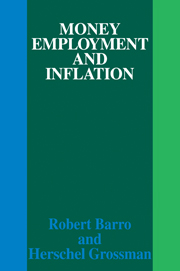Book contents
- Frontmatter
- Contents
- Dedication
- Preface
- Introduction
- 1 The basic model
- 2 Output and employment under non-market-clearing conditions
- 3 Capital, financial assets, and the rate of return
- 4 Inflation and rates of return
- 5 Inflation and unemployment
- 6 The dynamics of aggregate demand
- 7 Output and employment with wage and price speculation
- References
- Index of names
6 - The dynamics of aggregate demand
Published online by Cambridge University Press: 07 October 2011
- Frontmatter
- Contents
- Dedication
- Preface
- Introduction
- 1 The basic model
- 2 Output and employment under non-market-clearing conditions
- 3 Capital, financial assets, and the rate of return
- 4 Inflation and rates of return
- 5 Inflation and unemployment
- 6 The dynamics of aggregate demand
- 7 Output and employment with wage and price speculation
- References
- Index of names
Summary
This chapter explores the implications of various structural lags for the time paths of output, employment, and the rate of return. The various lags considered involve the responses of effective demands to their proximate determinants, the adjustment of expectations regarding future levels of income and the rate of return, and the response of the rate of return to divergences between the demand and supply of financial assets. The analysis focuses on the effects of a change in monetary policy. Section 6.1 considers the model, developed in chapter 3, dealing with the determination of output, employment, and the rate of return under general excess supply. Section 6.2 generalizes the implications of the gradual adjustment phenomenon. Section 6.3 deals with the implications of adaptive expectations. Section 6.4 considers gradual clearing of the financial asset market.
Gradual adjustment of money balances
As a point of departure for the present discussion, consider the analysis, developed in section 3.4 above, dealing with the determination of output, employment, and the rate of return under general excess supply. This analysis assumes that the given values of the wage rate and price level are such that excess supply exists in the markets for both labor services and commodities. Thus, the effective demands in the respective markets determine output and employment. The analysis also assumes that the rate of return takes that value which is consistent with effective clearing of the financial asset market.
- Type
- Chapter
- Information
- Money Employment and Inflation , pp. 211 - 237Publisher: Cambridge University PressPrint publication year: 1976



